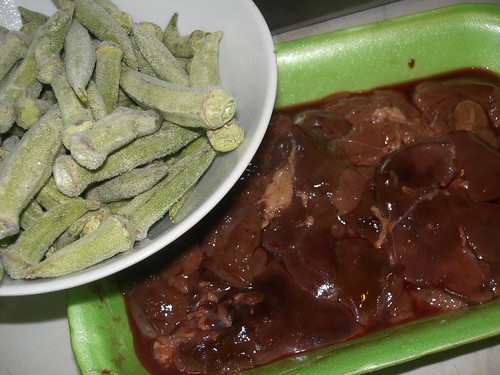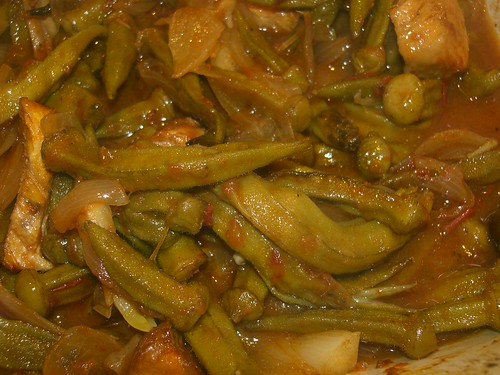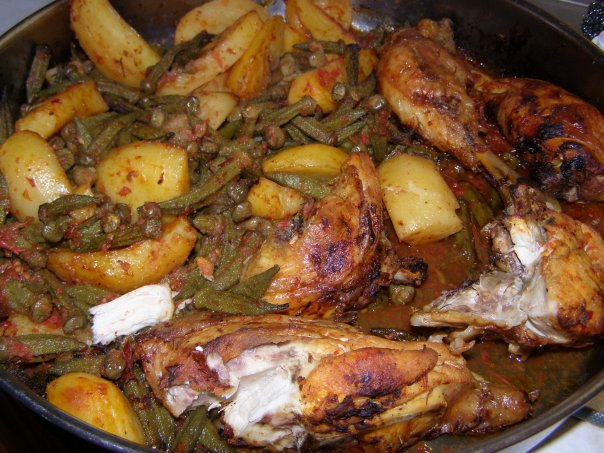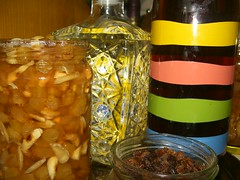This post is part of the Cook the Books blog event running until February 15, 2009, hosted by Deb from Kahakai Kitchen. Read Diana Abu Jaber's The Language of Baklava, and cook something inspired by the book. Post your inspiration on your blog and link to Cook the Books.)
WARNING: contains a spoiler - if you don't want to know about the story till you have read it, don't read the post!!
WARNING: contains a spoiler - if you don't want to know about the story till you have read it, don't read the post!!
The discovery of who we are and where we belong are both playing major roles in current models of ethnicity. People nowadays demand to be who they want to be (we can't be anyone else anyway), and to be recognised as such. Then there are the monocultural people (plenty of them, I'm afraid, even where I live) who can no longer avoid ignoring the multicultural aspects of their daily life and may be tempted to find out about the secret life of those who left a land with a strong culture and moved to the countries of the New World, continuing their Old World existence there through visible features of their past life, such as dress, entertainment and food. Through books like The Language of Baklava by Diana Abu-Jaber, the reality of living in two cultures side by side is being opened up to a world of people who had always wondered just what went on in the houses of those people who looked, sounded, smelt and tasted (in the figurative sense) different from what was supposedly the norm, because now we know, nothing in the present world can be considered the norm; all cultural identities in a politically correct world are now considered normal.
The Language of Baklava reminds us that food forms a fundamental part of cultural evolution. Had Diana's father not insisted on cooking meals originating from his Jordanian upbringing, and instead allowed her mother to cook according to her own family tradition (the just-add-water technique), Diana would not have been able to write her memoirs in quite the same way. Her book provides a great insight to those that aspired to monoculturalism about the secret life of their immigrant neighbour who holds barbecues on the front lawn, cooks food that sends out its aromas all the way to the next block and speaks loudly in a foreign language while maintaining a neutral tone when speaking English (which is the language that most of the New Worlds adopted as their main lingua franca).
Diana's story could be the story of the offspring of any immigrant's daughter who grew up knowing that life at home was not the same as life outside the boundaries of the four main walls of the house. Through her parents' mixed marriage, Diana was blessed with the best of both worlds, which probably helped her and her sisters to adapt themselves to any environment, except, that is, possibly that of food.
When you have been raised on real food - food that is cooked from scratch, with fresh raw ingredients, each one with its own unique taste, smell and texture - you cannot be passively uncritical of food that has been prepared for consumption in which the original ingredients have been disguised so well that it is impossible to tell whether what you are eating is flora- or fauna-derived. Here's one of my favorite excerpts from the book that deals with this subject:
"The [school] cafeteria is ... my first exposure to truly awful food: Its rotting, industrial stink permeates the room, and I come to think of this smell every time I hear the nuns speak of penance. I see for the first time foods dropped on molded plastic trays, items with names like tapioca, tuna casserole and rice pudding. These trays all hold a congealed, mealy gray mass that gazes sadly up at the ceiling."
Diana's upbringing has obviously been centred around food. Every season, every event, every feast day, every emotion has its own special recipe. Food is eaten on a social basis, with cousins, aunts and uncles featuring heavily. Whenever somebody 'comeover' (read the book to find out the special meaning of this unique phrase), they're always hungry. Food was always made for sharing, even to strangers (like the neighbours who wondered whether they should call the fire brigade at the sight of the barbecue in the front yard), and people who had already made preparations for that day's meal (like Sister at school, who ate at the school cafeteria).
The Language of Baklava is not just a story about someone's life; it is a collection of soulfully mouthwatering recipes. After reading only the first chapter, I had already decided what I was inspired to make from the book, until I read the next chapter, and decided to make two recipes instead of one, until I read the next chapter, and realised that I would either have to invite a lot of people to eat everything I had been inspired to make, or cook something from it every day until I had finished making all the food Diana describes in her book.
Diana's family's relationship with food mirrors my own. Everything just had to be: "Fuss, fuss, fuss, nothing's good enough, nothing's right, ... Only the little onions, the itty-bitty cucumbers, only the meat from his butcher." This is how Diana's grandmother described Diana's father's food fetishes. Reading about Diana's life, foodwise and otherwise, felt like reading my own biography.
Although I don't often read cookbooks (my home cooking schedule is too rigid to allow for great variation), I must admit that I found The Language of Baklava to be a very inspirational book in terms of the food, and I will probably be making more recipes from it. The ingredients used in most of them are commonly found in Greece, but I think my attraction to them is probably a combination of the setting and the proximity of my own culture with that of Diana Abu-Jaber's, plus the fact that most of the cooking - ingredients, techniques, dishes - are very similar to Greek cooking. I found it impossible to make only one dish from the book, as most recipes in The Language of Baklava were part of a pair or trio that are served together.

The okra was frozen after being prepared; I prefer not to defrost it when I cook it. Chicken livers are sold together with chicken hearts (which were cooked in another meal).
Seeking out uncommon ingredients has forever been an important part of my daily life: as a young child going on horta expeditions in Mt Victoria with my parents, as a teenager in my mother's kitchen, as a young woman living alone and cooking for myself, and now as a mother-of-two and wife-of-one (as I like to call myself). Chicken livers and okra certainly fit the bill here. They are unusual, and possibly contain an element of acquired taste.


My family's favorite okra dish - roast chicken and potatoes with the prepared okra added half-way through the cooking time.

A friend of mine once surprised me by serving what looked like an extremely simple meal of chicken livers fried with a lot of onions, which I'm extremely partial to. The recipe sounded just like Diana's "Nostalgic Chicken Livers" recipe. I can't bear to eat meat without some vegetables, so when I read about "Perfectly Tender Bamia", I knew just what to do with some okra I had frozen from the summer, prepared in the special way Greeks (and many Middle Eastern cultures) prepare their okra before cooking it so that it won't be slimy. These foods made me feel so special and lucky to be 'in the know', just like Diana; her mixed identity is so much a part of my own life, and her way of dealing with it took as much as time as it did for me to do the same thing. But I hope Diana forgives me for roasting the okra (which co-incidentally, the Greeks also call 'bamia'); I prefer mine crunchy.
*** *** ***
Although I don't often read cookbooks (my home cooking schedule is too rigid to allow for great variation), I must admit that I found The Language of Baklava to be a very inspirational book in terms of the food, and I will probably be making more recipes from it. The ingredients used in most of them are commonly found in Greece, but I think my attraction to them is probably a combination of the setting and the proximity of my own culture with that of Diana Abu-Jaber's, plus the fact that most of the cooking - ingredients, techniques, dishes - are very similar to Greek cooking. I found it impossible to make only one dish from the book, as most recipes in The Language of Baklava were part of a pair or trio that are served together.

The okra was frozen after being prepared; I prefer not to defrost it when I cook it. Chicken livers are sold together with chicken hearts (which were cooked in another meal).
Seeking out uncommon ingredients has forever been an important part of my daily life: as a young child going on horta expeditions in Mt Victoria with my parents, as a teenager in my mother's kitchen, as a young woman living alone and cooking for myself, and now as a mother-of-two and wife-of-one (as I like to call myself). Chicken livers and okra certainly fit the bill here. They are unusual, and possibly contain an element of acquired taste.


My family's favorite okra dish - roast chicken and potatoes with the prepared okra added half-way through the cooking time.

A friend of mine once surprised me by serving what looked like an extremely simple meal of chicken livers fried with a lot of onions, which I'm extremely partial to. The recipe sounded just like Diana's "Nostalgic Chicken Livers" recipe. I can't bear to eat meat without some vegetables, so when I read about "Perfectly Tender Bamia", I knew just what to do with some okra I had frozen from the summer, prepared in the special way Greeks (and many Middle Eastern cultures) prepare their okra before cooking it so that it won't be slimy. These foods made me feel so special and lucky to be 'in the know', just like Diana; her mixed identity is so much a part of my own life, and her way of dealing with it took as much as time as it did for me to do the same thing. But I hope Diana forgives me for roasting the okra (which co-incidentally, the Greeks also call 'bamia'); I prefer mine crunchy.


The silver tray is the traditional way to be served refreshments in the Mediterranean and Middle eastern countries. It is a symbol of high aspirations, respect and decency. Silver trays have become a thing of the pat, but I'm still partial to stainless steel. My 'silver tray' holds a glass of strained Greek yoghurt with quince dessert, a chocolate, an Algerian nougat sweet (a box was gifted to me by a student), Greek coffee and that ubiquitous glass of water served with everything you may eat or even drink all over Greece. Raki is the clear spirit in the decanter.
Now all that's left is the dessert. That's simple; if you were being served these dishes at a Greek restaurant, at the end of the meal, a simple dessert of strained yoghurt topped with quince dessert might be brought to you, along with the ubiquitous raki, which is similar to the araq spirit in Diana's Jordan. In Crete, it's more commonly referred to as tsikoudia. And just like baklava, raki and araq are related, practically sounding the same. To your health - fi sehtuk!
©All Rights Reserved/Organically cooked. No part of this blog may be reproduced and/or copied by any means without prior consent from Maria Verivaki.
I am at home here, in this post, and in the book. This is my story as well. A common thread growing up in a multi-culture setting, happily filled with real food from both cultures.
ReplyDeleteYou write so beautifully. I could not express myself this well.
I have this book Marie but it is in the queue. Thanks for the insights:D
ReplyDeleteThe okra with tomato sauce looks yummy. We call it 'bamya' similar to what it's called in Greek 'bamia' (no surprise there :) I like it soft, but my husband hates bamya. Although, he would eat it if it were cooked crunchy.
ReplyDeleteI am a fan of those silver serving trays. I want one. One day, I'll bring one from home.
The author is from Portland, which is right across the river from us!! I will have to look for the book:)
ReplyDeleteMarie,
ReplyDeleteWhat a lovely, insightful and thought-provoking post. I really enjoyed reading your thoughts on it and seeing how you applied the book to your own experiences. Your dishes look interesting and delicious. I have not cooked with okra yet and have been wanting too. Thanks for taking part in Cook The Books!
Aloha,
Deb
An enjoyable and thoughtful post. You brought up a lot of insights and themes from the book that I didn't fully appreciate (I read this book WAY too fast, as I loved it so) first time around. Now, about that okra....I've tried it in the past, Southern-style fried and it was sort of slimy. Maybe I'll have to try some roasted if I ever see okra fresh in the market.
ReplyDeleteI cracked up at the description of school cafeteria food. I distinctly remember when I was in elementary school and the hot lunch program was just getting started. They fed us soy burgers and lime jello with shredded cabbage in it. School lunches have come a loooong way! I actually like chicken livers, but I don't think I've ever had the hearts. As always, love reading your words.
ReplyDeletei hate slimy okra too, so i cook it in a way that does not allow it to turn out slimy (just follow the directions as i posted them in the links)
ReplyDeleteI finished reading this book on the airplane coming home. I thought of you often as I read it, as in so many ways it is your story as well.
ReplyDeleteLovely post Maria. The food sounds delicious; the family had kreas me bamies a couple weeks ago too.
ReplyDeleteYour tray looks beautiful and it sounds and looks like you've eloquently brought the book to life.
Lovely post Maria. I LOOOVE okra, but with chicken. Mmmm...a very summery dish indeed
ReplyDeleteI love the quince dessert! I get a lot of quince from my father in law and love it cooked down like that over yogurt.
ReplyDelete